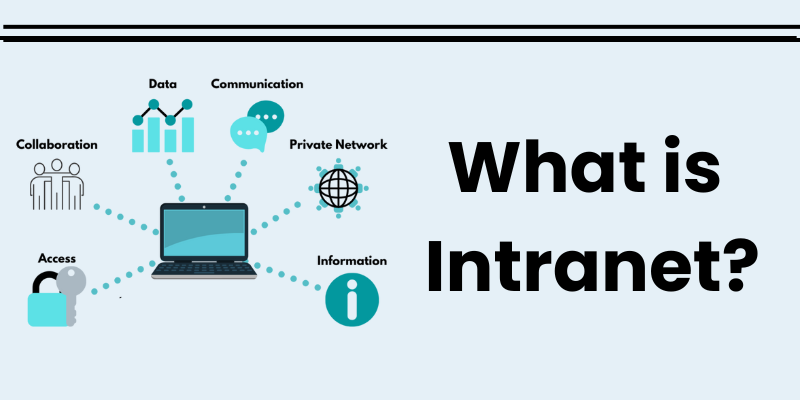What is intranet in computer : Everything You Need to Know
Published: 28 Jun 2025
Imagine having a private version of the internet, designed just for your organization. That’s exactly what an intranet offers, a secure platform where employees can communicate, share resources, and stay connected. Whether it’s managing projects, accessing important files, or improving teamwork, an intranet makes it all easier. But how does it work, and why is it essential for businesses today?

Let’s dive in and explore everything you need to know about intranets.
What is an Intranet?
An intranet is a private network used by companies to share information and resources among employees. Unlike the public internet, an intranet is secure and only accessible to people within the organization. It helps businesses improve communication, share documents, manage projects, and keep employees connected for better teamwork and efficiency.
Why Is It Important?
An intranet is vital for communication and teamwork. It helps employees share updates and stay informed. It provides quick access to documents and tools in one place. This reduces emails and saves time. Teams can work faster and stay productive.
How does an intranet work?
Here is a step-by-step guide to understanding how an intranet works and what makes it essential for organizations.
An intranet works through a computer network. Here’s how it usually works:
- Connection: All users connect their computers, tablets, or phones to the intranet, usually through Wi-Fi or a wired connection.
- Web Browser: Just like you use a web browser to visit websites on the internet, you can use it to access the intranet.
- Login: Users often need a special username and password to log in, making sure that only the right people can access the information.
- Navigation: Once logged in, users can navigate through different sections or pages, find information, and communicate with others.
Key Features of an Intranet
The following are some key features that make an intranet an essential tool for internal communication and collaboration within an organization:
Internal Communication:
Includes messaging tools, discussion boards, and announcements for effective communication.
Example: Company-wide newsletters can be shared through the intranet to keep everyone informed.

File Sharing and Storage:
Provides a centralized location for storing, organizing, and accessing important documents and files.
Employee Collaboration:
Offers tools such as shared calendars and project management systems to help teams work together efficiently and stay on schedule.
Personalization:
Custom dashboards allow different departments or employees to see content and tools relevant to their roles.
Security:
Intranets are secure networks, ensuring that only authorized users can access the information, and protect sensitive data from external threats.
Advantages of Intranet:
Here are some key advantages of using an intranet in an organization:
- Improves internal communication and collaboration.
- Centralizes access to resources and tools.
- Enhances productivity with streamlined workflows.
- Engages employees through interactive features.
- Increases data security and privacy.
Disadvantages of Intranet:
Below are some of the main disadvantages of using an intranet in an organization:
- Can be costly to set up and maintain.
- Requires regular updates and maintenance.
- May face resistance from employees adapting to new technology.
- Risk of information overload with too much data.
- Not always mobile-friendly, limiting access on the go.
Types of Intranets
Intranets can vary based on their structure and purpose; the following are some common types of intranets used by organizations:”
- Traditional Intranets:
- Basic networks are designed for sharing documents, messages, and company announcements.
- Typically static and limited in terms of advanced features.
- Modern Intranets:
- Integrated with advanced tools and technologies, such as cloud platforms and collaboration software.
- Offer enhanced features for better functionality, such as real-time editing and seamless access from anywhere.
- Social Intranets:
- Focused on promoting employee interaction and collaboration.
- Include social features like forums, chat rooms, and activity feeds to encourage teamwork and engagement among employees.
Examples of Intranet
Both large companies and new startups offer intranet solutions, so you have lots of options to choose from. The following are examples of Intranet.
- Blink
- Facebook Workspace
- Happeo
- HCL Connection
- Hyperoffice Atlas
- Samepage
- Simpper
- Zoho Connect
- Work vivo
- Staffbase
- Jostle
- Microsoft SharePoint
- Passageways OnSemble
- Microsoft Yammer
Conclusion
Intranets are essential for improving communication, collaboration, and efficiency in the workplace. They make it easier to access resources, share information, and stay organized.
With new trends like AI and mobile-friendly designs, intranets are becoming even smarter and more useful for modern businesses.
Want to boost workplace efficiency? Explore intranet solutions now! See how they improve communication and teamwork. Have questions or ideas? Share in the comments below!
FAQs
Below are some frequently asked questions (FAQs) to help you better understand intranet.
The Internet is a global network open to everyone, while an intranet is a private network for specific users, usually within a company or organization.
Yes, small businesses can benefit from intranets by improving communication, organizing resources, and streamlining processes, even with limited teams.
Intranets are highly secure because they use restricted access and encryption to protect sensitive company data. Only authorized users can log in.
There are three types of intranets.
- Corporate Intranet
- Departmental Intranet
- Project-Based Intranet
An intranet is a private network that only people in an organization can use. It helps employees communicate share information and work together.
Yes, with the right security measures like VPNs, employees can access the intranet from remote locations.
Intranets improve communication, enhance collaboration, centralize documents, and boost overall productivity within an organization.
An intranet is usually managed by a company’s IT department or system administrators to ensure smooth operation and security.
Yes, modern intranets can integrate with tools like email, calendars, project management software, and cloud services to streamline workflows.
No, a company website is public and intended for external users, while an intranet is private and used internally by employees.

- Be Respectful
- Stay Relevant
- Stay Positive
- True Feedback
- Encourage Discussion
- Avoid Spamming
- No Fake News
- Don't Copy-Paste
- No Personal Attacks

- Be Respectful
- Stay Relevant
- Stay Positive
- True Feedback
- Encourage Discussion
- Avoid Spamming
- No Fake News
- Don't Copy-Paste
- No Personal Attacks





